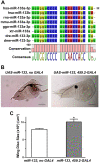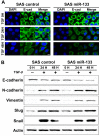MicroRNA-133 Targets Phosphodiesterase 1C in Drosophila and Human Oral Cancer Cells to Regulate Epithelial-Mesenchymal Transition
- PMID: 34335946
- PMCID: PMC8317528
- DOI: 10.7150/jca.56138
MicroRNA-133 Targets Phosphodiesterase 1C in Drosophila and Human Oral Cancer Cells to Regulate Epithelial-Mesenchymal Transition
Abstract
Non-coding microRNAs (miRNAs) have been proposed to play diverse roles in cancer biology, including epithelial-mesenchymal transition (EMT) crucial for cancer progression. Previous comparative studies revealed distinct expression profiles of miRNAs relevant to tumorigenesis and progression of oral cancer. With putative targets of these miRNAs mostly validated in vitro, it remains unclear whether similar miRNA-target relationships exist in vivo. In this study, we employed a hybrid approach, utilizing both Drosophila melanogaster and human oral cancer cells, to validate projected miRNA-target relationships relevant to EMT. Notably, overexpression of dme-miR-133 resulted in significant tissue growth in Drosophila larval wing discs. The RT-PCR analysis successfully validated a subset of its putative targets, including Pde1c. Subsequent experiments performed in oral cancer cells confirmed conserved targeting of human PDE1C by hsa-miR-133. Furthermore, the elevated level of miR-133 and its targeting of PDE1C was positively correlated with enhanced migrative ability of oral cancer cells treated with LPS, along with the molecular signature of a facilitated EMT process induced by LPS and TGF-β. The analysis on the RNAseq data also revealed a negative correlation between the expression level of hsa-miR-133 and the survival of oral cancer patients. Taken together, our mammal-to-Drosophila-to-mammal approach successfully validates targeting of PDE1C by miR-133 both in vivo and in vitro, underlying the promoted EMT phenotypes and potentially influencing the prognosis of oral cancer patients. This hybrid approach will further aid to widen our scope in investigation of intractable human malignancies, including oral cancer.
Keywords: Drosophila melanogaster; Epithelial-Mesenchymal Transition; PDE1C; mammal-to-Drosophila-to-mammal approach; microRNA-133; oral cancer.
© The author(s).
Conflict of interest statement
Competing Interests: The authors have declared that no competing interest exists.
Figures






Similar articles
-
MicroRNA-31 Regulates Expression of Wntless in Both Drosophila melanogaster and Human Oral Cancer Cells.Int J Mol Sci. 2020 Sep 30;21(19):7232. doi: 10.3390/ijms21197232. Int J Mol Sci. 2020. PMID: 33007980 Free PMC article.
-
MicroRNA-92a promotes epithelial-mesenchymal transition through activation of PTEN/PI3K/AKT signaling pathway in non-small cell lung cancer metastasis.Int J Oncol. 2017 Jul;51(1):235-244. doi: 10.3892/ijo.2017.3999. Epub 2017 May 16. Int J Oncol. 2017. PMID: 28534966
-
MiR-134/487b/655 cluster regulates TGF-β-induced epithelial-mesenchymal transition and drug resistance to gefitinib by targeting MAGI2 in lung adenocarcinoma cells.Mol Cancer Ther. 2014 Feb;13(2):444-53. doi: 10.1158/1535-7163.MCT-13-0448. Epub 2013 Nov 20. Mol Cancer Ther. 2014. PMID: 24258346
-
Epithelial-mesenchymal transition-associated miRNAs in ovarian carcinoma, with highlight on the miR-200 family: prognostic value and prospective role in ovarian cancer therapeutics.Cancer Lett. 2014 Sep 1;351(2):173-81. doi: 10.1016/j.canlet.2014.05.022. Epub 2014 Jun 18. Cancer Lett. 2014. PMID: 24952258 Review.
-
Emerging Role of MicroRNA-200 Family in Dentistry.Noncoding RNA. 2021 Jun 11;7(2):35. doi: 10.3390/ncrna7020035. Noncoding RNA. 2021. PMID: 34208375 Free PMC article. Review.
Cited by
-
Oral Squamous Cell Carcinoma Exosomes Upregulate PIK3/AKT, PTEN, and NOTCH Signaling Pathways in Normal Fibroblasts.Curr Issues Mol Biol. 2025 Jul 19;47(7):568. doi: 10.3390/cimb47070568. Curr Issues Mol Biol. 2025. PMID: 40729037 Free PMC article.
-
Study of MicroRNA (miR-221-3p, miR-133a-3p, and miR-9-5p) Expressions in Oral Submucous Fibrosis and Squamous Cell Carcinoma.Indian J Clin Biochem. 2023 Jan;38(1):73-82. doi: 10.1007/s12291-022-01035-x. Epub 2022 Apr 29. Indian J Clin Biochem. 2023. PMID: 36684498 Free PMC article.
-
Uterus proliferative period ceRNA network of Yunshang black goat reveals candidate genes on different kidding number trait.Front Endocrinol (Lausanne). 2023 May 12;14:1165409. doi: 10.3389/fendo.2023.1165409. eCollection 2023. Front Endocrinol (Lausanne). 2023. PMID: 37251683 Free PMC article.
-
MicroRNAs in Cancer and Cardiovascular Disease.Cells. 2022 Nov 10;11(22):3551. doi: 10.3390/cells11223551. Cells. 2022. PMID: 36428980 Free PMC article. Review.
-
miRNAs in the diagnosis and therapy of cardiac and mediastinal tumors: a new dawn for cardio-oncology?Future Cardiol. 2024;20(14):795-806. doi: 10.1080/14796678.2024.2419225. Epub 2024 Nov 8. Future Cardiol. 2024. PMID: 39513219 Review.
References
-
- Bartel DP. MicroRNAs: genomics, biogenesis, mechanism, and function. Cell. 2004;116:281–97. - PubMed
-
- De Angelis R, Sant M, Coleman MP, Francisci S, Baili P, Pierannunzio D. et al. Cancer survival in Europe 1999-2007 by country and age: results of EUROCARE-5-a population-based study. Lancet Oncol. 2014;15:23–34. - PubMed
-
- Pignon JP, le Maitre A, Maillard E, Bourhis J, Group M-NC. Meta-analysis of chemotherapy in head and neck cancer (MACH-NC): an update on 93 randomised trials and 17,346 patients. Radiother Oncol. 2009;92:4–14. - PubMed
-
- Hussein AA, Helder MN, de Visscher JG, Leemans CR, Braakhuis BJ, de Vet HCW. et al. Global incidence of oral and oropharynx cancer in patients younger than 45 years versus older patients: A systematic review. Eur J Cancer. 2017;82:115–27. - PubMed
-
- Soga D, Yoshiba S, Shiogama S, Miyazaki H, Kondo S, Shintani S. microRNA expression profiles in oral squamous cell carcinoma. Oncol Rep. 2013;30:579–83. - PubMed
LinkOut - more resources
Full Text Sources
Molecular Biology Databases

